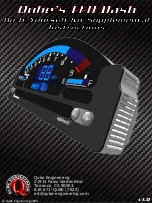
5
FAQ
FAQ
At
what
depth
of
discharge
(DOD)
does
the
battery
experience
1
cycle?
There
is
no
point
at
which
a
discharge
counts
as
1
cycle.
Each
cycle
puts
wear
on
the
battery
proportional
to
its
depth
of
discharge.
If
the
battery
is
discharged
to
80%
every
cycle,
it
will
last
~
2000
cycles.
If
the
battery
is
cycled
at
70%
DOD,
the
battery
will
last
~3,000
cycles.
This
has
a
nonlinear
effect
on
the
total
amp
‐
hour
output
of
the
battery
over
its
lifetime.
The
smaller
the
DOD
is,
the
larger
the
total
Ah
output
of
the
battery
is.
Comparing
the
lifetime
output
of
two
100
Ah
batteries
at
80%
and
70%
DOD,
the
total
Ah
output
can
be
idealized
by
the
following:
100Ah*0.8DOD*2000=160,000Ah
total
output,
100Ah*0.7DOD*3000=210,000Ah
total
output.
In
reality
the
total
lifetime
output
numbers
will
be
closer
together,
as
factors
such
as
battery
aging
are
not
being
considered,
however
the
70%
DOD
battery
will
still
output
more
Ah
over
its
lifetime.
This
is
the
main
reason
why
opportunity
charging
is
a
perfect
fit
for
LiFT
Packs.
CELL
CHEMISTRY
AND
CONSTRUCTION
What
types
of
Lithium
‐
ion
chemistries
are
available,
and
why
do
we
use
LiFePO
4
?
There
are
a
number
of
different
chemistries
available.
Flux
uses
LiFePO
4
due
to
its
long
cycle
life,
low
cost
of
ownership,
thermal
stability,
and
high
power
output.
Below
is
a
chart
which
provides
some
information
on
alternative
Lithium
‐
ion
chemistries.
Specifications
Li
‐
cobalt
LiCoO
2
(LCO)
Li
‐
manganese
LiMn
2
O
4
(LMO)
Li
‐
phosphate
LiFePO
4
(LFP)
NMC
1
LiNiMnCoO
2
Voltage
3.60V
3.80V
3.30V
3.60/3.70V
Charge
limit
4.20V
4.20V
3.60V
4.20V
Cycle
life
500
500
2,000
2,000
Operating
temperature
Average
Average
Good
Good
Specific
energy
150–190Wh/kg
100–135Wh/kg
90–120Wh/kg
140
‐
180Wh/kg
Loading
1C
10C,
40C
pulse
35C
continuous
10C
Safety
Average.
Average
Very
safe
Safer
than
Li
‐
cobalt.
Thermal.
runaway
150°C
(302°F)
250°C
(482°F)
270°C
(518°F)
210°C
(410°F)
*Battery
University


























